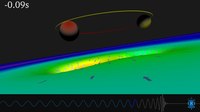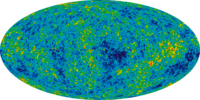
Seismic noise measures for underground gravitational wave detectors
Sign Up to like & getrecommendations! Published in 2019 at "Acta Geodaetica et Geophysica"
DOI: 10.1007/s40328-019-00257-5
Abstract: AbstractThe site characterisation of future underground gravitational wave detectors is based on spectral properties of the low frequency seismic noise. The evaluation of the collected long term seismological data in the Mátra Gravitational and Geophysical… read more here.
Keywords: seismic noise; wave detectors; gravitational wave; underground gravitational ... See more keywords

Exploration of co-sputtered Ta2O5–ZrO2 thin films for gravitational-wave detectors
Sign Up to like & getrecommendations! Published in 2021 at "Classical and Quantum Gravity"
DOI: 10.1088/1361-6382/ac1b06
Abstract: We report on the development and extensive characterization of co-sputtered tantala–zirconia (Ta2O5-ZrO2) thin films, with the goal to decrease coating Brownian noise in present and future gravitational-wave detectors. We tested a variety of sputtering processes… read more here.
Keywords: thin films; wave detectors; gravitational wave; ta2o5 zro2 ... See more keywords

Broadband quantum noise reduction in future long baseline gravitational-wave detectors via EPR entanglement
Sign Up to like & getrecommendations! Published in 2019 at "Physical Review D"
DOI: 10.1103/physrevd.100.083011
Abstract: Broadband quantum noise reduction can be achieved in gravitational-wave detectors by injecting frequency-dependent squeezed light into the dark port of the interferometer. This frequency-dependent squeezing can be generated by combining squeezed light with external filter… read more here.
Keywords: broadband; gravitational wave; noise reduction; quantum noise ... See more keywords

Detectability of ultralight scalar field dark matter with gravitational-wave detectors
Sign Up to like & getrecommendations! Published in 2019 at "Physical Review D"
DOI: 10.1103/physrevd.100.123512
Abstract: An ultralight scalar field is one of the dark matter candidates. If it couples with Standard Model particles, it oscillates mirrors in gravitational-wave detectors and generates detectable signals. We study the spectra of the signals… read more here.
Keywords: gravitational wave; field; dark matter; ultralight scalar ... See more keywords

Localization of binary neutron star mergers with second and third generation gravitational-wave detectors
Sign Up to like & getrecommendations! Published in 2018 at "Physical Review D"
DOI: 10.1103/physrevd.97.104064
Abstract: The observation of gravitational wave signals from binary black hole mergers has established the field of gravitational wave astronomy. It is expected that future networks of gravitational wave detectors will possess great potential in probing… read more here.
Keywords: gravitational wave; binary neutron; wave detectors; astronomy ... See more keywords

Squeezed States of Light for Future Gravitational Wave Detectors at a Wavelength of 1550 nm.
Sign Up to like & getrecommendations! Published in 2022 at "Physical review letters"
DOI: 10.1103/physrevlett.129.121103
Abstract: The generation of strongly squeezed vacuum states of light is a key technology for future ground-based gravitational wave detectors (GWDs) to reach sensitivities beyond their quantum noise limit. For some proposed observatory designs, an operating… read more here.
Keywords: wavelength 1550; states light; noise reduction; wave detectors ... See more keywords

Single-Frequency Fiber Amplifiers for Next-Generation Gravitational Wave Detectors
Sign Up to like & getrecommendations! Published in 2018 at "IEEE Journal of Selected Topics in Quantum Electronics"
DOI: 10.1109/jstqe.2017.2759275
Abstract: At the beginning of 2016, the first direct detection of a gravitational wave by a laser-based Michelson interferometer has been reported. So far, the number of confirmed detections has raised to three and will certainly… read more here.
Keywords: single frequency; wave detectors; gravitational wave; wave ... See more keywords

Amorphous dielectric optical coatings deposited by plasma ion-assisted electron beam evaporation for gravitational wave detectors.
Sign Up to like & getrecommendations! Published in 2023 at "Applied optics"
DOI: 10.1364/ao.477186
Abstract: Coating thermal noise (CTN) in amorphous coatings is a drawback hindering their application in precision experiments such as gravitational wave detectors (GWDs). Mirrors for GWDs are Bragg's reflectors consisting of a bilayer-based stack of high-… read more here.
Keywords: plasma ion; ion assisted; wave detectors; gravitational wave ... See more keywords

Calculation method for light scattering caused by multilayer coated mirrors in gravitational wave detectors.
Sign Up to like & getrecommendations! Published in 2017 at "Optics express"
DOI: 10.1364/oe.25.004741
Abstract: Scattered light in inteferometric gravitational wave detectors needs to be reduced so that it will not harm the actual signals coming from a gravitational wave. In this paper, we report on the application of the… read more here.
Keywords: method light; wave detectors; gravitational wave; calculation method ... See more keywords

Tantalum oxide and silicon oxide mixture coatings deposited using microwave plasma assisted co-sputtering for optical mirror coatings in gravitational wave detectors.
Sign Up to like & getrecommendations! Published in 2022 at "Applied optics"
DOI: 10.1364/oic.2022.wb.2
Abstract: This work presents the characterization of the optical and mechanical properties of thin films based on (T a 2 O 5)1-x (S i O 2)x mixed oxides deposited by microwave plasma assisted co-sputtering, including post-annealing… read more here.
Keywords: coatings gravitational; microwave plasma; assisted sputtering; plasma assisted ... See more keywords

Higher-order Laguerre-Gauss modes in (non-) planar four-mirror cavities for future gravitational wave detectors.
Sign Up to like & getrecommendations! Published in 2017 at "Optics letters"
DOI: 10.1364/ol.42.000751
Abstract: One of the limiting noise sources in the current generation of gravitational wave detectors, such as the advanced laser interferometer gravitational wave observatory (aLIGO), is the thermal noise in the interferometer's test mass coatings. One… read more here.
Keywords: wave detectors; gravitational wave; wave; higher order ... See more keywords